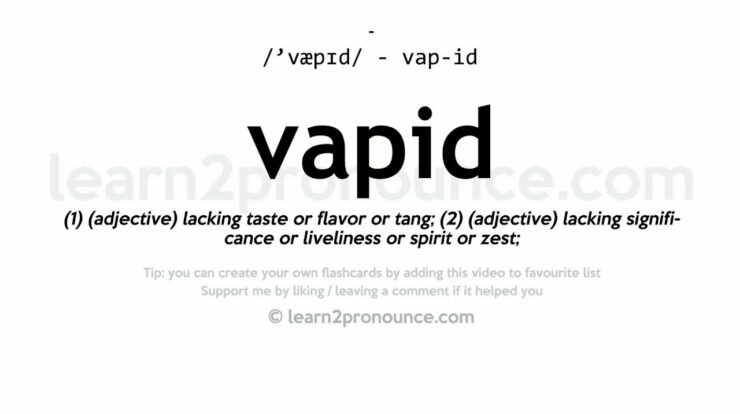
Vapid definition, meaning devoid of substance or significance, has become increasingly prevalent in modern communication. This exploration delves into the characteristics, impact, and strategies for overcoming vapidity, shedding light on its pervasive nature and potential consequences.
Originating from the Latin word “vapidus,” meaning “flat” or “tasteless,” vapidity has evolved to encompass a broader spectrum of shallow and empty expressions.
Vapidity: A Lack of Substance and Meaning

Vapidity, a pervasive issue in communication, refers to language or behavior that is devoid of substance, depth, or originality. It manifests in empty words, shallow arguments, and superficial interactions that fail to engage or convey meaningful content.
Definition and Etymology
The term “vapid” originates from the Latin word “vapidus,” meaning “flat” or “tasteless.” It accurately captures the essence of vapid language, which lacks any distinctive flavor or stimulating qualities.
Characteristics of Vapidity, Vapid definition
- Empty and Uninformative:Vapid communication lacks substance and fails to convey any meaningful information.
- Repetitive and Unoriginal:It relies heavily on clichés, platitudes, and overused phrases, offering nothing new or insightful.
- Lack of Depth and Detail:Vapid statements fail to provide any depth or specific details, making them superficial and unmemorable.
- Focus on Appearance Over Content:Vapid language often prioritizes style over substance, emphasizing superficial qualities like eloquence or wit at the expense of meaningful content.
Vapidity differs from emptiness or shallowness in that it actively misleads the recipient by creating the illusion of substance where none exists.
Impact and Consequences of Vapidity
Vapid communication can have detrimental effects on individuals and society:
- Misunderstandings and Confusion:Lack of clarity and substance can lead to misunderstandings and confusion, hindering effective communication.
- Lack of Engagement:Vapid language fails to engage or inspire, resulting in disinterest and boredom among listeners.
- Erosion of Trust:Repeated exposure to vapid communication can erode trust in the speaker or writer, as their words are perceived as empty and insincere.
Examples of Vapidity
- Political Speeches:Generic statements and empty promises that lack specific policies or actionable plans.
- Marketing Jargon:Buzzwords and clichés that fail to convey any meaningful information about a product or service.
- Social Media Posts:Superficial updates and meaningless affirmations that lack depth or originality.
Overcoming Vapidity
Improving communication and avoiding vapidity requires conscious effort:
- Clarity and Specificity:Use precise language and provide specific details to convey meaningful content.
- Authenticity and Originality:Express genuine thoughts and perspectives, avoiding clichés and empty phrases.
- Depth and Insight:Provide depth and insight by supporting statements with evidence, examples, or personal experiences.
- Avoid Overused Phrases:Strive for originality and freshness in language, avoiding overused phrases or platitudes.
Last Recap: Vapid Definition

Overcoming vapidity requires conscious effort to prioritize clarity, specificity, and authenticity in communication. By embracing these principles, individuals can enhance their ability to engage in meaningful and impactful conversations, fostering deeper connections and fostering a more intellectually stimulating environment.
Key Questions Answered
What are key characteristics of vapid communication?
Vapid communication often lacks substance, clarity, and depth. It may rely on clichés, empty phrases, or vague generalizations.
How can vapidity impact individuals and society?
Vapid communication can lead to misunderstandings, disengagement, and a lack of trust. It can also hinder critical thinking and problem-solving.
What strategies can help overcome vapidity?
To overcome vapidity, focus on using precise language, avoiding jargon, and providing specific examples to support your points.





